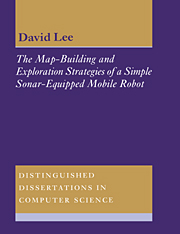 The Map-Building and Exploration Strategies of a Simple Sonar-Equipped Mobile Robot
The Map-Building and Exploration Strategies of a Simple Sonar-Equipped Mobile Robot Book contents
- Frontmatter
- Contents
- Preface
- 1 Question, Context and Method
- I Starting Points
- II System Components
- 5 The Robot
- 6 Modelling the Sonar Sensor
- 7 Map Construction
- 8 Path Planning
- 9 Localisation
- 10 Map Quality Metrics
- III Experiments
- Appendix A The Feature-Map Data Structure
- Appendix B Test Rooms
- Appendix C Finding the Best-Fit Line
- Appendix D ARNE's Standard Dialogue
- Bibliography
- Index
5 - The Robot
Published online by Cambridge University Press: 05 March 2012
- Frontmatter
- Contents
- Preface
- 1 Question, Context and Method
- I Starting Points
- II System Components
- 5 The Robot
- 6 Modelling the Sonar Sensor
- 7 Map Construction
- 8 Path Planning
- 9 Localisation
- 10 Map Quality Metrics
- III Experiments
- Appendix A The Feature-Map Data Structure
- Appendix B Test Rooms
- Appendix C Finding the Best-Fit Line
- Appendix D ARNE's Standard Dialogue
- Bibliography
- Index
Summary
ARNE's key physical component is a 300 mm diameter disc which supports the control electronics and the rotating sonar sensor. Below the disc is a chassis which holds the motors and shaft encoders to control the two drive wheels.
5.1 Hardware
ARNE has a drive wheel on each side of the chassis and a low-friction castor at the back. It moves holonomically, turning the wheels in the same direction to move forward or in opposite directions to rotate on the spot. Shaft encoders with a precision of 1024 steps per revolution determine the distance travelled by each wheel to a precision of 0.2 mm.
At the lowest level, the wheel movements are controlled by two dedicated HCTL-1100 motion control chips (Hewlett-Packard 1992, pages 1–77 to 1–115) which generate and execute trapezoidal velocity profiles. The length, acceleration and peak velocity of these movements are specified by the on-board CPU, a 68000-compatible ‘Mini-Module’ micro controller from PSI Systems Limited (PSI 1991).
ARNE's only range sensor is a single rotating Polaroid ultrasonic rangeflnder (Polaroid 1991) which can be seen in Figure 5.1 on top of the box which houses the CPU and other control electronics. The transducer is rotated by a stepper motor with a minimum step size of 1.8°. A full 360° scan is performed in twenty 18° steps.
Section 1.3 explained the decision to connect ARNE to a stationary workstation. A 9600–baud connection to the Mini Module's RS485 serial port was used for this purpose.
- Type
- Chapter
- Information
- The Map-Building and Exploration Strategies of a Simple Sonar-Equipped Mobile RobotAn Experimental, Quantitative Evaluation, pp. 49 - 54Publisher: Cambridge University PressPrint publication year: 1996
